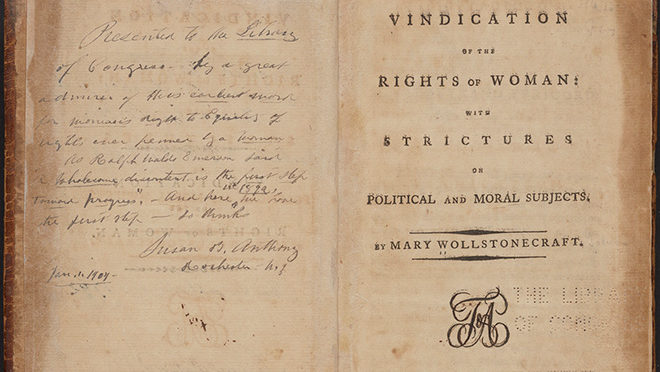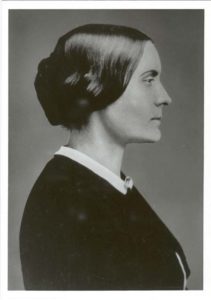Post written by Jenny Hannifin, Archive Assistant.
Women’s Suffrage in Colorado: 1893 and Carrie Chapman Catt
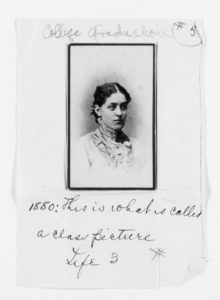
National Archives: Carrie Chapman Catt Papers: Miscellany; Photographs; 1890 – 1920.
In 1893, it was Carrie Chapman Catt’s turn to help Colorado women earn the right to vote.
- “In the midst of a severe economic depression [the Panic of 1893, a depression not matched again until the 1930], the rallying cry of ‘Let the Women Vote!’ was heard from Denver to Durango.” (Brochure, 1893-1993: Colorado Suffrage Centennial; Local History Archive vertical file, LC – Civil Rights – Women’s Suffrage)
In our first Women’s Suffrage in Colorado blog we looked at events leading up to the failed attempt to grant women’s suffrage in Colorado in 1877, and Susan B Anthony’s time in Colorado. In this post we will learn about Carrie Chapman Catt’s time in Colorado, and a happier outcome: women’s suffrage achieved in 1893.
In Colorado in 1893, after decades of work by suffragists across the country, enfranchisement efforts ramped up again. Denverite Ellis Meredith travelled to the World’s Fair in Chicago to convince Susan B Anthony to return to Colorado for a second try at enfranchisement. This time around, Colorado suffragists were linking women’s right to vote to “equal rights,” rather than to temperance (Suffrage: Women’s Long Battle for the Vote, Ellen C. Dubois: Simon & Schuster, 2020; p 135).
- “Ellis Meredith … was both a married woman and a professional journalist, a combination difficult to imagine just a few years before. … She preferred to be called Ellis Meredith, a gender-neutral first name of her own invention and the last name she was born with. In 1893 she was already a journalist for the Rocky Mountain News.” (Dubois page 133)
Convinced by Meredith, Susan B Anthony sent to Colorado a rising young star of the movement named Carrie Chapman Catt (learn more about Catt here).
- Carrie Lane Chapman Catt spoke at Opera House in Fort Collins “very near to election time” (Triangle Review, November 12, 1980, page 1)
- “One is hard pressed to find any unfavorable coverage of either Chapman’s meetings or the referendum in general. It is certainly a far different atmosphere than during the 1877 campaign.” (History Colorado, link above)
The final vote on November 7, 1893, was 55% in favor of suffrage and 45% against. “Equal suffrage, women’s enfranchisement, won in Colorado and won strongly.” (Dubois page 137).
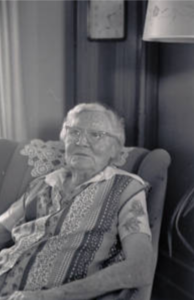
Margaret Portner, pictured here, believes her mother’s scrapbook contains pictures of Elizabeth Cady Stanton and Susan B Anthony (Coloradoan, August 23, 1978). Image: T03153
1919-1920: The Nineteenth Amendment
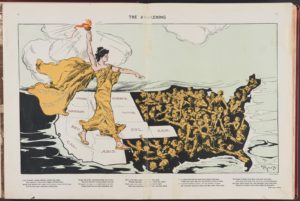
Suffrage Follows Lady Liberty Eastward
The Awakening: Hy [Henry] Mayer. Puck, vol. 77, no. 1981 (February 20, 1915). Library of Congress 0312.00.00
When the national suffrage campaign was waged in 1919, Colorado was helpful – but only after persistent negotiating by Coloradan suffragists.
“In Colorado, where women had been voting for a quarter of a century, Republican governor Oliver Henry Shoup, considered to be a long-standing friend of suffrage, was one of those who refused to call a special legislative session to ratify. … If suffragists insisted, the governor said they would have to pay all expenses … Suffragists’ counteroffer was to serve as ‘stenographers, pages and clerical help’ without pay. In mid-June, Shoup accepted and announced he would call a special session.” (Dubois, page 259)
Carrie Chapman Catt came west again, spending three days in fall 1919 in Denver, and pleading with Coloradans to vote for those who didn’t have the right yet. Governor Shoup called a special session, and on December 12, both houses of the Colorado legislature passed the bill, to no opposition (Dubois, page 260).
On August 26, 1920, the Nineteenth Amendment became part of the constitution.
- “Women have suffered agony of soul which you can never comprehend, that you and your daughters might inherit political freedom. That vote has been costly. Prize it!” – Carrie Chapman Catt, 1920
It wasn’t easy and it wasn’t fast
In both 1877 and 1893, not everyone supported the movement:
- “Housewives! You do not need the ballot to clean out your sink spout.” (Fence Post, August 9, 1993, referring to “one of the leaflets of the day”)
- In Fort Collins, “[female faculty member] Alice Curtis impressed young students like Justus Wilkinson with her accounts of chaining herself to posts in the battle for the suffrage amendment.” (Fort Collins Yesterdays p. 237)
And after national suffrage was achieved in 1920, not a lot of women voted.
- “By the first of January 1894, only two Fort Collins women had registered to vote – Miss Grace Patton and Mrs. Jessie West.” (Triangle Review, November 12, 1980, page 1)
- Learn more about Grace Patton here and Jessie West here.
After ratification of the 19th amendment, much remained to accomplish true equality. Wives were still economically dependent, women workers were woefully underpaid, and in half the states, women could not even sit on juries. In a future blog, we will look at later movements of the 20th century, particularly in the 1970s, as the women’s struggle for equal rights continued.
- “The struggle for women’s suffrage was one that transcended territorial boundaries and state lines. It covered entire generations, and lasted all the way from the American Revolution, through the entire 19th century, and right up until the Roaring Twenties. It was a unifying struggle that brought women, and men, from all across the nation together. (History Colorado).
When you visit the Archive, here’s a list of local suffrage resources:
- LC – Civil Rights – Women’s Suffrage
- LC – Organizations – Women – Women’s Christian Temperance Union
- LC – Organizations – Women
- BIO – Ammons, Theodosia*
- Fort Collins Courier, 12/30/1897: The Non-Partizan [sic] Colorado Equal Suffrage Association
- LC – Civil Rights – Women’s Movement
- BIO – Sabin, Florence Rena
- BIO – Thorpe, Violet
Educational opportunities like this are supported in part by Fort Fund.



